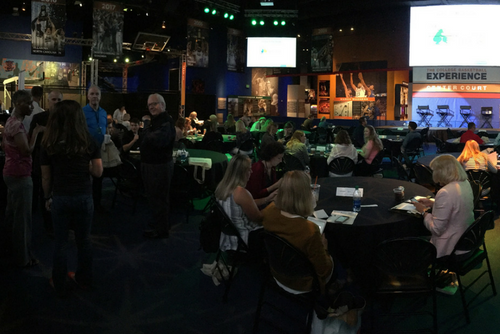Virtual events are not a new concept. Prior to the pandemic, you might have attended the occasional webinar or virtual training session. However, since COVID-19 first made its way into the United States, we have seen a significant increase in all things digital—and events are no exception. Northstar Meetings Group surveyed 805 event planners and found that they are seeing an increase in demand for virtual events for the next 12-18 months. Event planners aren’t the only ones taking notice of the new trend—the technology sector is cashing in. In the last few months, we have seen large investments in virtual event platform startups, such as Bevy.com, Run the World and Hopin.
Given the increase in demand and the rise in technology, now would be a great time to find ways to layer virtual events into your marketing strategy. Although we’ve traditionally favored in-person events over virtual ones, for the past few months, emfluence has been putting together virtual content and participating in virtual tradeshows. These include weekly virtual Q&A Sessions—we call them Weekly Emsights, based on viewers’ feedback so that we can provide timely and relevant content. We’ve jumped in on virtual Beer + Learns, recorded webinars, and spoken at several virtual speaking gigs. After four months of planning, promoting and executing, we have some thoughts and advice on replacing in-person events with virtual events.
Pros of Virtual Events
There are some attractive reasons to run a virtual event instead of a physical one:
- Hosting your event on a virtual platform makes it accessible to a larger audience since people can attend from anywhere.
- Virtual events require less planning and therefore have a faster turnaround, logistically speaking.
- Virtual events are less expensive—you don’t have the added costs of travel, vendors, venues, etc.
- You can use social tools and chats to increase engagement.
- Virtual events make some attendees feel more comfortable engaging. 47% of people are more likely to ask questions at a virtual event and 37% are more likely to speak to a person in a virtual booth versus a real one (Eventbrite).
- Virtual events have long-term value. You can record the event and repurpose different segments or make it available for your prospects and clients to watch later.
- Virtual events are great for growing your marketing list! When people register online, say from a landing page that was created using a marketing automation platform, it is easier to encourage them to subscribe to other content such as newsletters.
Cons of Virtual Events
Virtual events lack personal connection.
While it’s true that you won’t make the same connections that you would at an in-person event, you can use engagement tools to counteract this, such as an online space for attendees to connect. For example, this year’s Digital Summit at Home set up a Slack workspace with multiple channels pertaining to different topics where sponsors and attendees could interact and ask questions—they were even able to chat during sessions!
During virtual events, attendees are more distracted.
For those of us working from home, there are tons of distractions—partners, kids, pets, noisy neighbors, etc. If you are worried that you may not be able to hold your audience’s attention, you can try engaging them by using an online Q&A, survey or chat feature during the event. Survey respondents have a 49% higher attentiveness score (GoToWebinar).
Technology issues are a concern.
While the same can be said for certain aspects of in-person events, it is true that there is more technology involved with virtual events. You can mitigate the risk by practicing and testing everything ahead of time. You should also have a Plan B, such as an extra headset or the event pulled up on another device in case the one you’re using crashes. You can even record sessions ahead of time instead of going live.
Lead generation is a challenge.
Without a place for casual conversation, like a booth or networking happy hour, getting true sales qualified leads can be difficult. Instead of measuring a virtual event like you would an in-person event, treat your prospects like marketing qualified leads. Add in more layers of nurture and find ways for your prospects to engage with relevant content and offers.
Our Advice for Virtual Events
Use virtual webinars to address current trends.
Since virtual events can be put together a lot more quickly than in-person events, we can be nimble and responsive to current trends even as they rapidly change.
Include invitations to your virtual events in campaigns and be sure to invite current clients or prospects.
Virtual events are a great nurture touch point and help to establish your organization as a thought leader.
If your physical event gets canceled, you can still use paid media through social channels to continue the conversation.
Suggest ways in which your clients and prospects can continue to engage. Include calls to action, such as signing up for a demo, registering for a webinar or downloading a whitepaper.
If you’re like us and had to cancel your annual conference, consider ways in which you can make it virtual.
One idea we discussed was sending out a “Conference in a Box”—a box filled with swag and instructions on how to access digital content. Consider adding in branded gifts (and don’t forget to ask where those gifts should be sent!) or giving access to digital learning tracks that include whitepapers, videos, blogs and more.
If you are replacing a physical event that people would typically pay to attend, consider charging a small fee.
It is easy to blow off a free event, so if this is a special event, you can charge a small fee to attend. $10-$25 adds enough value so that the event is affordable, but people will be less likely to flake out. You can also allow attendees to apply the cost to a future in-person event to add more value. However, it’s important to remember to gate any recordings so that only people who paid have access if you want to maintain that value.
Survey your audience often for tips on what they liked, didn’t like and what topics you should cover in future events.
They may have great ideas!
Know that virtual won’t last forever
Once people can gather safely again in person, you may see a dip in engagement with virtual events. Measure attendance regularly and see if the lift is still worth the production.
The coronavirus pandemic may have been the catalyst for a permanent shift to all things digital, including events. It could be several months before we can safely make in-person connections again, and what that will look like remains to be seen. For now, we should be finding ways to translate our in-person events into virtual events and integrate them into our marketing strategies so we can continue to make meaningful connections.




Virtual selling is the reality many salespeople currently face with COVID-19. As we increasingly get used to the flexibility remote work provides, we might need to accept there is no change in sight.
Thank you so much for sharing all this wonderful info, Great share, found the articles really worth reading.!